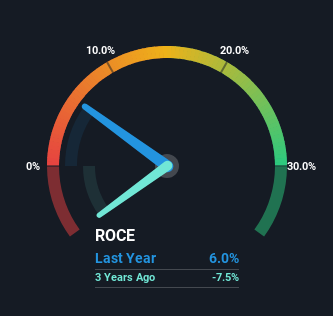Returns On Capital At Scholastic (NASDAQ:SCHL) Have Stalled
If we want to find a stock that could multiply over the long term, what are the underlying trends we should look for? One common approach is to try and find a company with returns on capital employed (ROCE) that are increasing, in conjunction with a growing amount of capital employed. This shows us that it's a compounding machine, able to continually reinvest its earnings back into the business and generate higher returns. However, after investigating Scholastic (NASDAQ:SCHL), we don't think it's current trends fit the mold of a multi-bagger.
Understanding Return On Capital Employed (ROCE)
If you haven't worked with ROCE before, it measures the 'return' (pre-tax profit) a company generates from capital employed in its business. Analysts use this formula to calculate it for Scholastic:
Return on Capital Employed = Earnings Before Interest and Tax (EBIT) ÷ (Total Assets - Current Liabilities)
0.06 = US$66m ÷ (US$1.7b - US$609m) (Based on the trailing twelve months to February 2024).
Thus, Scholastic has an ROCE of 6.0%. Ultimately, that's a low return and it under-performs the Media industry average of 11%.
View our latest analysis for Scholastic
In the above chart we have measured Scholastic's prior ROCE against its prior performance, but the future is arguably more important. If you'd like to see what analysts are forecasting going forward, you should check out our free analyst report for Scholastic .
The Trend Of ROCE
Things have been pretty stable at Scholastic, with its capital employed and returns on that capital staying somewhat the same for the last five years. Businesses with these traits tend to be mature and steady operations because they're past the growth phase. So unless we see a substantial change at Scholastic in terms of ROCE and additional investments being made, we wouldn't hold our breath on it being a multi-bagger.
In Conclusion...
In summary, Scholastic isn't compounding its earnings but is generating stable returns on the same amount of capital employed. And investors may be recognizing these trends since the stock has only returned a total of 6.9% to shareholders over the last five years. Therefore, if you're looking for a multi-bagger, we'd propose looking at other options.
Scholastic could be trading at an attractive price in other respects, so you might find our free intrinsic value estimation for SCHL on our platform quite valuable.
While Scholastic isn't earning the highest return, check out this free list of companies that are earning high returns on equity with solid balance sheets.
Have feedback on this article? Concerned about the content? Get in touch with us directly. Alternatively, email editorial-team (at) simplywallst.com.
This article by Simply Wall St is general in nature. We provide commentary based on historical data and analyst forecasts only using an unbiased methodology and our articles are not intended to be financial advice. It does not constitute a recommendation to buy or sell any stock, and does not take account of your objectives, or your financial situation. We aim to bring you long-term focused analysis driven by fundamental data. Note that our analysis may not factor in the latest price-sensitive company announcements or qualitative material. Simply Wall St has no position in any stocks mentioned.

